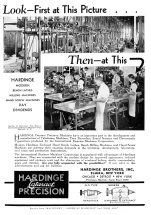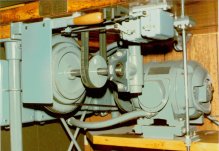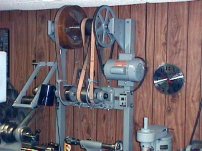At Brooklyn Technical High School, there were a number of machine shop classrooms not too much different than the photo. Bklyn Tech dated to 1922 or thereabouts, and the line-shaft driven machine shops were original, new when the "new" Brooklyn Tech HS building opened for students. Some earlier generation of 'Tech students had taken to calling the line shaft driven machine shops "Belt Jungles". Some of the original "Belt Jungles" had been modernized with new LeBlond Regal lathes and other motor driven machine tools. Some "Belt Jungles" were a mix of newer motor driven machine tools and some line-shaft driven original machine tools. I remember using bench lathes where we had to step on pedals to shift the belts (tight and loose pulleys). I can also recall our machine shop teachers showing us kids 'how to walk a belt'. There was maybe a 16" or 18" swing cone-head engine lathe, driven from a cone pulley on a countershaft up in the overhead. The teacher shifted the belt to the countershaft to get the lathe turning under power. He then used the edge of his hand to hit the moving belt, knocking it off the step of the headstock cone pulley it had been running on. With a good shot from the edge of his hand, the teacher had that moving belt climb onto the next steps on the countershaft and headstock pulleys. He walked the belt up and down the step cone pulleys. As he explained, you had to look out for the lacing hooks if you used your hand. Us kids were told to use a hammer handle of the smooth shank of an open-end wrench or a piece of round stock. We walked belts after that. We also learned that if a belt was too slack, a classmate could help you get your work done. Namely, the classmate took a large open end wrench with an smooth oval cross section to its handle, or a hammer handle, and used it to apply pressure to the slack belt. This got the belt to where it did not slip and you got your cut taken. Then, you returned the favor for your classmate. These 'belt jungles' had leather flat belting, and the belting was not 'taken down' (run off the pulleys) except over summer vacation time. Humidity and being under constant tension caused the lathe belts to stretch and remain slackened. The teachers had belt dressing in stick form, which helped some. Otherwise, they'd put in a request for the machine shop maintenance crew to take a piece out of that belt.
We kids worked on ca 1922 machine tools and thought "War Production Board" geared head lathes and horizontal mills were "modern". We ran engine lathes, shapers, horizontal mills, camelback drills, radial drills and plenty more. No safeguards or emergency stops with braking. Other than an occasional cut finger or skinned knuckle or bruise, there were never any serious accidents. We had great teachers who had 'come out of industry'. I got a wonderful education at Brooklyn Technical HS, as did thousands of other boys (it was an all boys school up until the 1970's or thereabouts). Lineshaft machine shops are from an era when people were expected to take responsibility for their own actions, no safety shutdowns or guards on moving machine parts. If you were not capable of 'knowing where your body began and ended' and working with forethought and working safely, it was on you if you got hurt. No digital readout and plenty of wear so you had to know how to take out the backlash or take a heavy enough final cut to keep worn machine tool parts from 'swimming around'. There were no 'youtubes' to show you how to do machine shop work, no smartphones or other devices to do your thinking. We were taught to setup jobs on old machine tools and how to figure out how to operate machine tools without any manuals, nor were there labels or data plates on too much other than lathe quick change gearboxes or feed boxes on mills and radial drills. Progressive generations have gotten softer and expect to use some kind of artificial intelligence rather than their own minds, eyes, bodies, and maybe a 'Machinery's Handbook" and a pad of paper and the micrometer collars on the machine tools.



